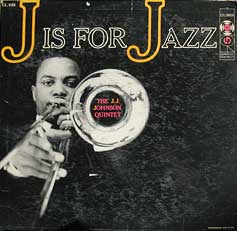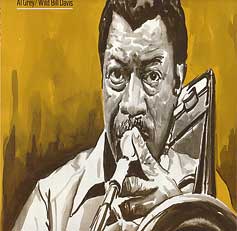Gearing up for more incredible content here. In the meantime, an interesting post is (posted) at Keep Swinging, a Dutch blog in (Dutch) but also in English. A lot of other good stuff is there as well.
Category Archives: Jazz
Dr. Vernick, I Presume
Note: Some of the links below will take you to the iTunes music store.
Recently, while searching the jungle of the iTunes music store, I came across an interesting iTunes U/Podcast by Dr. Gordon Vernick titled Jazz Insights.

Vernick, who heads up the jazz studies program at Georgia State University, started Jazz Insights as a 10-minute radio show: short vignettes on the basics of jazz for the uninitiated. Since then, he’s continued the program by covering the work of individual jazz artists and their place in the history of the music.
On a series of shows about J.J. Johnson, an initial mention of the slide trombone’s recalcitrant nature is inevitable. Vernick says:
The Trombone is a very difficult instrument. It’s a very ancient instrument. It’s been around for hundreds, if not thousands of years…
It’ll come as no surprise that Dr. Vernick uses recordings as one of the vehicles to recount a jazz artist’s career and development. Continuing with Johnson — the only trombonist featured so far — Vernick begins with J.J.’s early swing-style playing on Lester Leaps In for Norman Granz’s Jazz At the Philharmonic. Johnson’s emerging be-bop style is illustrated by I Mean You with Coleman Hawkins and How Deep Is the Ocean? with Charlie Parker, before we hear classic be-bop dates with J.J. as the leader. By the end of the 40s, we hear how J.J. cooled off a bit.
While recounting his career in the 50s, Vernick discusses Johnson’s involvement in the somewhat short-lived idea of Third Stream Music (A Mix of Jazz and Classical Music) by playing us some of the rare recording Birth of the Third Stream, while getting to J.J.’s musical connection to Miles Davis. Naturally, there’s also discussion of The Eminent J.J. Johnson Volumes One and Two. Along the way, Vernick includes some other important Johnson recordings, including Jay and Kai + 6 (below, courtesy YouTube) and Stan Getz and J.J. Johnson at the Opera House.
I won’t spoil it by recounting all of Vernick’s show on J.J. here. You really should go give it a listen yourself. Vernick’s presentational style is friendly and geared towards a jazz novice, but it’s still interesting if you happen to know more. In other words, Jazz Insights is aptly named. Plus, Dr. Vernick has recorded programs on Jackie McLean, Thad Jones, Scott LaFaro, Stan Getz, and other artists. Check it out.
April Mea Culpa
First things first: it’s time to apologize for the lack of updates here in the month of April. April, which according to poet T.S. Elliot is the cruelest month, is also Jazz Appreciation Month, and National Poetry Month. Cruel, certainly. There were horribly destructive tornadoes in the southern U.S. (Learn more, and how you might help, here).
Fortunately, it’s always jazz appreciation month on this website. Some jazz-in-April links: Over at Jazzwax, Marc Myers is up for two jazz journalist association awards. David Brent Johnson’s Nightlights radio show featured bassist Scott Lafaro, amongst others. Undated, but musician Danny Barnes wrote a great article about how to play in someone else’s band. Don’t forget Donna over at Elements of Jazz dot com. She’s got the Twitter Jazzerati list over there, as well as other great stuff.
And the weather? It was also too cold for April in Minnesota, even in Minnesota. More soon…
Al Grey/Wild Bill Davis: Keybone
Update: This recording seems to be gone from the iTunes store again. iTunes links below will take you to the main Al Grey feature page.
It’s good to see that the Al Grey/Wild Bill Davis album Keybone is at the iTunes music store. A short story: I bought the vinyl version of Keybone when I was on a band trip to New York City with The Pride of Southland Marching Band. Yes, that was some time ago. In those days, jazz records had a definite inventory limit at Record Bars across the country, which meant that getting to New York City was a golden opportunity to find some off-the-beaten-path jazz records. I’m not sure I remember how, but I found King Karol records easily — probably at the 42nd street location — and was happy to find a huge jazz section.
Here’s how I found out about Keybone on iTunes: I had transferred some of the vinyl tracks to digital myself. With the correct track info entered into iTunes, one day iTunes found the Keybone artwork. Voila! — apparently it had been added to iTunes.
Anyway, it’s a fun set of music, and was recorded in 1972 at Seed Studios in Vallauris, France. The rest of the personal includes Eddie Vinson on alto saxophone (Vinson sings on Alimony Blues and Person To Person), Floyd Smith on guitar and Chris Columbus on drums. Check it out; this is a good set of music.
Dan Wynn: Art of the Cover
Last time, I wrote about the varying quality of digital transfers at the iTunes music store, specifically on some Kai Winding and J.J. Johnson recordings. The odd situation I mentioned was that newer cover art sometimes accompanies some digital transfers of the albums — even from a scratchy LP as the source ― while the original cover art sometimes accompanies separate digital transfers, which — possibly ― come from the original master tapes.
But wait — there are more geeky details: below is the original LP cover art for J Is For Jazz. Look familiar? The striking photo sets J.J. against a black background, head-on down the length of his trombone slide, just like the art for Kai Winding’s The Trombone Sound (See the last post, which appeared far too long ago).

What you can’t see on the iTunes cover art is the photo credit that exits on the LP versions. Not surprisingly, both of these album cover photos are by the same photographer, Dan Wynn, who died in 1995. Although he had training in art, Wynn began developing technical skills in photography while serving in the U.S. Army Air Force during World War II. Out of the Army in 1947, he began focussing his photographic eye on fashion while working for Seventeen Magazine. In his subsequent career, he ended up photographing nearly everything — cars and scooters, food, models, movie stars, and, of course, musicians.

.jpg)
